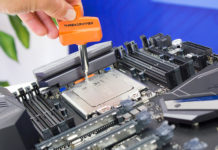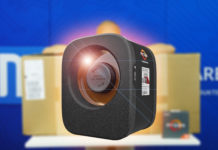While waiting for the Nehalem platform to launch, Intel has updated its 45nm Wolfdale core from C0 to E0 stepping. We have taken a closer look at what the new stepping has to offer in terms of overclocking and power consumption.
Intel’s 45nm circuits have been out and about for close to 12 months now without any real competition. When chips have been available for such a long period of time they have usually gone through a whole bunch of minor adjustments and changes. These include everything from small bug fixes to substantial improvements in terms of power consumption and higher efficiency. Higher efficiency may sound a bit vague but it means that they have tuned the parameters of the processors to reduce delays thus improving performance. Another pleasant side effect is that the overclocking potential is often improved.

Core 2 Duo E8600 launched recently and with it we saw the introduction of a new stepping. The previous stepping of the E8000 series was “C0”, while E8600 had been blessed with the new “E0”. At the introduction of a new stepping other models are usually also transferred to the new stepping that also inherits its properties. Normally it takes a while before these updated steppings find their ways into stores but thanks to a pair of eagle eyes we were able to find an E8400 with this stepping.
We start by taking a look at the equipment for this article.
 | |
Test system | |
| Hardware | |
| Motherboard | ASUS P5Q3 Deluxe |
| Processors | Intel Core 2 Duo E8500 (6MB), C0 Intel Core 2 Duo E8400 (6MB), E0 |
| Memory | CSX Diablo3 2000 (2x1024MB) |
| Graphics card | NVIDIA GeForce 8800GTX |
| Power supply | Corsair 1000HX |
For this article we’ve chosen a motherboard based on Intel’s latest chipset, P45, from ASUS with DDR3 support. We’ve tested this motherboard before with good results here at NordicHardware, which you can read about by following the link below.
ASUS P5Q3 Deluxe has a well balanced price, thanks to the P45 chipset, and performance on par with X48 thanks to DDR3. The same goes for the memory from CSX that we tested a while back. Intel’s E8400, that is now starting to appear in an E0 suit and with a price tag of around $160 fits well with the other hardware. The question is if this could become a real budget beast.
The new stepping doesn’t reveal much from its predecessor, in this case an E8500 with C0 stepping. The cooler may do well in a calm environment, but we will not pass any grades here from an enthusiasts point of view.
For this test we will use Thermalright Ultra Extreme 120 with a decent fan. We start by looking at the power consumption.
Measurements
To make the results as comparable as possible we used the exact same hardware, with the obvious exception of the processor, and the same settings for both processors. This means that we downclocked the E8500 CPU to 9x multiplier to achieve the same frequency as E8400.
The measurements was conducted using an ampere meter connected in series with the +12V feed for the voltage supply for the processor to measure the current to the processor. As we’ve mentioned in the past it has to be said that the measured current is the current that the power supply of the motherboard pulls from the connector. This includes the heat dissipation of the processor, but also the heat of the power supply and other potential consumers. The voltage feed (vcore) has a major impact on the power consumption, so we set it to the exact same value in BIOS. Temperature is an important component that affects power consumption and numbers in the table was not taken before these had stabilized.
Power consumption – Idle |
||||
| Processor | vcore | Current | +12V | Power |
| E8500 (C0) | 1.250V | 0.560A | 12.17V | 6.8W |
| E8400 (E0) | 1.250V | 0.348A | 12.22V | 4.3W |
If we start by looking at the numbers as a part of a bigger picture. A power consumption of 4.3W is extremely little for such a high-performing processor as E8400. The equivalent for QX9650 is about 15W. What about full load?
Power consumption – Full load |
||||
| Processor | vcore | Current | +12V | Power |
| E8500 (C0) | 1.250V | 3.952A | 11.53V | 45.6W |
| E8400 (E0) | 1.250V | 3.325A | 11.68V | 38.8W |
Once again it is the E0 processor that consumes less power than the C0 model. The E0 model is about 15% cooler than the predecessor. These numbers should be put in relation to the Thermal Design Power (TDP) that Intel says is 65W for both models. When we compared QX9770 to QX9650 in a previous article we saw about the same difference, that QX9770 emitted about 15% more heat than QX9650. In the same article we also concluded that the processor with higher power consumption overclocked better. Even though it would be wrong to make any conclusions from the two different steppings, many want to know if you can do just that. Is it so that the E0 processor is actually a worse overclocker than the older C0?
We compare the overclocking potential on the next page.
Low voltage was not the strength of E8500, but as soon as we surpass 1.20V things turn for the better and the frequency scales up well beyond 4GHz. The stated frequencies are considered stable by completing one round of Cinebench 9.5. For the processor to be stable enough for Folding@Home at 4GHz we needed to boost the voltage to 1.34V. What about the new E0-stepped E8400 processor?
With the previous information in fresh memory, the E0 processor did not stand up well to the tested E8500 processor. In previous articles we’ve talked about how the processor manufacturers tests all chips to determine the frequency, I.e. model, that the core can be sold as, so called speed binning. Judging from the circulating results with the E8600 model, that also sports the E0 stepping, we were hoping for a lot more. Apparently we were not very fortunate.
At the moment we are tweaking the E8400 processor to see what we need to get it running Folding@Home at 4GHz. We hope to publish these results in Folding-related threads in the forum.
We conclude our experiences from this article comparing the E0 and C0 steppings on the next page.
Power consumption
The purpose of this article was to investigate the physical changes, that we could measure, between Intel’s two steppings for dual-core processors, E0 and C0. Our own measurements show that the newer of the two, E0, emits about 15% less heat than the predecessor under full load. When idle the improvement is substantially bigger with a power consumption of 4.3W compared to 6.8W for C0. A possible explanation to this is less leakage that has a negative impact on power consumption, but…
Overclocking
…when it comes to the overclocking leakage may be preferred. High-performing silicon is usually classified high leakage by engineers. Our previous tests with quad-core processors points to that higher power consumption results in better overclocking potential. The potential of the E0-stepped E8400 processor we have test, compared to the C0-stepped E8500, shows that we cannot quite reach the same frequencies at the same voltage.
Conclusion
Making the conclusion that the E0 stepping is a worse overclocker than the C0 stepping would be plain wrong, this is clearly shown by all of the results with the E8600 model. The conclusions we can make is that all E0-stepped processors are not necessarily better than the C0 stepping just because of the stepping. It’s also possible that we have a lemon in our possession. Though there is no doubt that Intel is making progress with the E0 stepping and we are working on similar tests to investigate the high leakage phenomena.
 |
We want to thank Intel for sending us the E8500 processor for evaluation.






























